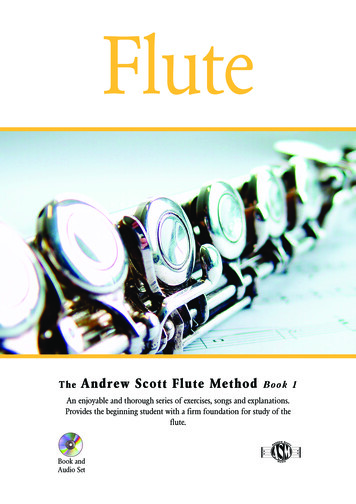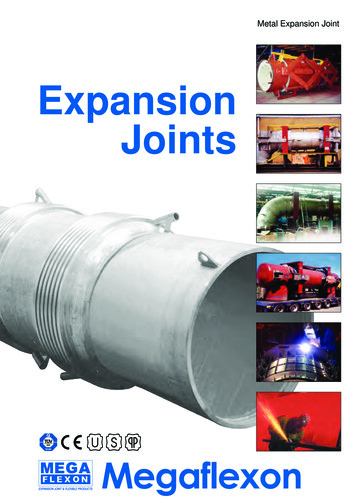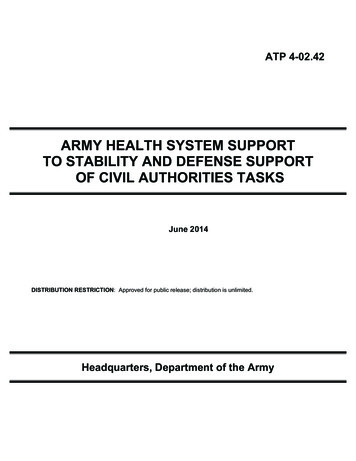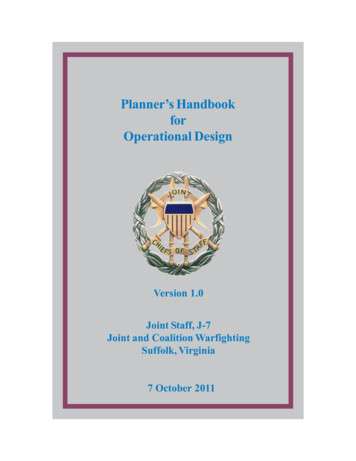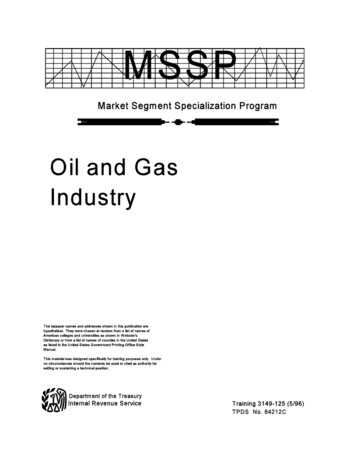
Transcription
Joint Publication 3-09.3Joint Tactics, Techniques,and Procedures forClose Air Support (CAS)3 September 2003Incorporating Change 12 September 2005
PREFACE1.ScopeThis publication provides joint tactics, techniques, and procedures (JTTP) for joint fire support andaviation planning, execution and control agencies, and aircrews in fixed- and rotary-wing aircraft toattack targets in close proximity to friendly forces. It presents options the joint force commander (JFC)can employ when planning and executing close air support in joint operations.2.PurposeThis publication has been prepared under the direction of the Chairman of the Joint Chiefs of Staff.It sets forth doctrine and selected JTTP to govern the joint activities and performance of the ArmedForces of the United States in joint operations and provides the doctrinal basis for US military involvementin multinational and interagency operations. It provides military guidance for the exercise of authorityby combatant commanders and other JFCs and prescribes doctrine and selected tactics, techniques, andprocedures for joint operations and training. It provides military guidance for use by the Armed Forcesin preparing their appropriate plans. It is not the intent of this publication to restrict the authority of theJFC from organizing the force and executing the mission in a manner the JFC deems most appropriate toensure unity of effort in the accomplishment of the overall mission.3.Applicationa. Doctrine and selected tactics, techniques, and procedures and guidance established in thispublication apply to the commanders of combatant commands, subunified commands, joint task forces,and subordinate components of these commands. These principles and guidance also may apply whensignificant forces of one Service are attached to forces of another Service or when significant forces ofone Service support forces of another Service.b. The guidance in this publication is authoritative; as such, this doctrine (or JTTP) will be followedexcept when, in the judgment of the commander, exceptional circumstances dictate otherwise. If conflictsarise between the contents of this publication and the contents of Service publications, this publicationwill take precedence for the activities of joint forces unless the Chairman of the Joint Chiefs of Staff,normally in coordination with the other members of the Joint Chiefs of Staff, has provided more currentand specific guidance. Commanders of forces operating as part of a multinational (alliance or coalition)military command should follow multinational doctrine and procedures ratified by the United States.i
PrefaceFor doctrine and procedures not ratified by the United States, commanders should evaluate and followthe multinational command’s doctrine and procedures, where applicable and consistent with US law,regulations, and doctrine.For the Chairman of the Joint Chiefs of Staff:JAMES A. HAWKINSMajor General, USAFVice Director, Joint StaffiiJP 3-09.3
SUMMARY OF CHANGESREVISION OF JOINT PUBLICATION 3-09.3,DATED 1 DECEMBER 1995 Defines and discusses the position of joint terminal attack controller(JTAC). Provides expanded guidance on the uses of close air support (CAS), toinclude targeting. Adds guidance on the joint air attack team. Updates conditions required for effective CAS. Renames the “air operations center” as the “Air Force air and spaceoperations center.” Adds a discussion of Navy/Marine Corps command and control inamphibious operations. Discusses special operations forces terminal guidance operations. Provides a discussion of CAS intelligence, surveillance, and reconnaissancerequirements. Consolidates coverage of planning and requesting CAS into one chapter. Adds the five steps of CAS decision-making process. Adds a new chapter on CAS preparation to include rehearsals and precombat preparations. Provides detailed discussion of joint terminal attack controller to combatoperations center/tactical operations center coordination.iii
Summary of Changesiv Provides detailed discussion on the 3 types of CAS terminal attack control. Mandates verbal or digital read-back of Line 4 (elevation), Line 6 (targetlocation), and any restrictions provided by the JTAC from the 9-line CASbriefing. Discusses urban CAS. Provides guidance on CAS execution with laser and inertial navigationsystem/global positioning system guided weapons. Eliminates Appendices on communications equipment and aircraft andhelicopter capabilities. Adds the term “terminal attack control” and modifies the definitions of theterms “terminal control” and “terminal guidance” in Joint Publication 1-02. Change 1 clarifies the types of CAS terminal attack control and updatesrisk estimate distance data for aircraft-delivered ordnance.JP 3-09.3 (CH 1)
TABLE OF CONTENTSPAGEEXECUTIVE SUMMARY . ixCHAPTER IINTRODUCTION, ORGANIZATION, AND FUNDAMENTALS Introduction .Close Air Support Defined .Use of Close Air Support .Close Air Support Integration .Fratricide .Fixed- and Rotary-Wing Close Air Support Employment .Conditions for Effective Close Air Support .Responsibilities.I-1I-1I-3I-4I-4I-5I-6I-8CHAPTER IICOMMAND, CONTROL, COMMUNICATIONS, COMPUTERS, INTELLIGENCE,SURVEILLANCE, AND RECONNAISSANCE General . II-1Close Air Support for Joint Force Operations . II-1Air Force/Army Command and Control . II-3Navy Command and Control . II-11Marine Corps Command and Control . II-13Navy/Marine Corps Command and Control in Amphibious Operations . II-15Special Operations Command and Control . II-15Communication Systems . II-17Intelligence, Surveillance, and Reconnaissance . II-23CHAPTER IIIPLANNING AND REQUESTING Introduction . III-1Deliberate Planning . III-1Crisis Action Planning . III-1Close Air Support in the Decision-making Process . III-1Command and Staff Responsibilities . III-11Close Air Support Planning Considerations . III-12Integrating Close Air Support with Surface Fire Support . III-20Requesting Close Air Support . III-26Forward Air Controller (Airborne) Planning . III-30v
Table of ContentsCHAPTER IVPREPARATION Introduction . IV-1Rehearsals . IV-2Pre-Combat Preparations . IV-6Communications . IV-7Movement/Positioning . IV-10CHAPTER VEXECUTION Introduction . V-1Joint Terminal Attack Controller to Combat Operations Center/TacticalOperations Center Coordination . V-1Close Air Support Target Engagement . V-21Close Air Support Aircraft Tactics . V-29Limited Visibility/Adverse Weather Considerations . V-40Terrain Considerations . V-46Laser, Inertial Navigation System/Global Positioning System Guided, andDigital Information Systems . V-52AC-130 . V-61APPENDIXA Planning Considerations for Close Air Support Using Night Vision Devicesand Infrared Pointers . A-1B Joint Tactical Air Strike Request (DD Form 1972). B-1C Sample Close Air Support Aircrew Mission Planning Guide . C-1D Risk-Estimate Distances . D-1E References . E-1F Administrative Instructions . F-1GLOSSARYPart IPart IIAbbreviations and Acronyms . GL-1Terms and Definitions . ons for Effective Close Air Support . I-6Joint Force Close Air Support Connectivity . II-2Component Air Command and Control Agencies for Close Air Support . II-3United States Air Force/United States Army Communications Nets . II-4Air Force/Army Close Air Support Connectivity . II-6Subordinate Theater Air Control System Agencies . II-7Navy/Marine Corps Close Air Support Connectivity . II-12Amphibious Tactical Air Control System Communications Network . II-16JP 3-09.3
Table of 25V-26V-27B-1D-1Special Operations Close Air Support Connectivity . II-18Close Air Support Integration Model . III-2Planning Phase . III-4Fire Support Coordinating Measures . III-22Formal Airspace Coordination Area . III-24Joint Airspace Control Measures . III-25Close Air Support Request and Types of Missions . III-26Preplanned Close Air Support Request Channels . III-27Immediate Close Air Support Request Process . III-29Immediate Close Air Support Request Channels . III-30Preparation Phase . IV-1Close Air Support Execution . V-2Formal Airspace Coordination Area Terminology . V-3Artillery-Close Air Support Aircraft Lateral Separation . V-4Artillery-Close Air Support Aircraft Altitude Separation . V-5Artillery-Close Air Support Aircraft Altitude and Lateral Separation . V-6Artillery-Close Air Support Aircraft Time Separation . V-7Offset Direction. V-9Standard Marking Brevity Terms . V-10Standard Laser Brevity Terms . V-11Close Air Support Check-In Briefing . V-22Close Air Support Briefing Form (9-Line) . V-23Abort Call Illustration . V-26Joint Terminal Attack Controller’s Calls . V-27Inflight Report . V-28Fixed-Wing Close Air Support Attack Phase Example . V-33Coordinated Attack Types . V-34Movement Techniques . V-37Example of Rotary-Wing Close Air Support Tactics . V-38Night Infrared Close Air Support Brevity Terms . V-45Urban Grid . V-50Objective Area Reference Grid . V-50Building Reference Grid . V-51Target Reference Points . V-51Airborne and Ground Designators Advantages and Disadvantages . V-55Example of Safety Zone and Optimal Attack Zones. V-57AC-130 Call for Fire . V-63Adjusting Rounds for the AC-130 Gunship . V-64Joint Tactical Air Strike Request (DD Form 1972) . B-5Risk-Estimate Distances . D-2vii
Table of ContentsIntentionally BlankviiiJP 3-09.3
EXECUTIVE SUMMARYCOMMANDER’S OVERVIEW Discusses Organization for and Fundamentals of Close Air Support Describes Close Air Support Command, Control, Communications,Computers, Intelligence, Surveillance and Reconnaissance (C4ISR) Describes Planning and Requesting Close Air Support Discusses Preparation for Close Air Support Outlines Execution of Close Air SupportFundamentals of Close Air SupportClose air support (CAS) isair action by fixed- androtary-wing aircraft againsthostile targets that are inclose proximity to friendlyforces and which requiredetailed integration of eachair mission with the fire andmovement of those forces.Close air support (CAS) can be conducted at any place and timefriendly forces are in close proximity to enemy forces. The word“close” does not imply a specific distance; rather, it is situational. Therequirement for detailed integration because of proximity, fires, ormovement is the determining factor. At times CAS may be the bestmeans to exploit tactical opportunities in the offense or defense. CASprovides firepower in offensive and defensive operations to destroy,disrupt, suppress, fix, harass, neutralize, or delay enemy forces.CAS may be used to mass the effects of combat power, in order toexploit opportunities in the offense and defense. Each Serviceorganizes, trains, and equips to employ CAS within its roles aspart of the joint force. As a result, a variety of aircraft are capableof performing CAS. The joint force commander (JFC) and his staffmust be capable of integrating all CAS capabilities into the operationplan.A joint terminal attack controller (JTAC) is a qualified (certified) servicemember who, from a forward position, directs the action of combataircraft engaged in CAS and other air operations. A qualified andcurrent JTAC will be recognized across Department of Defense ascapable and authorized to perform terminal attack control.ix
Executive SummaryFor joint air operationsproviding CAS, integrationstarts at the operational levelduring the airapportionment process.Whether conducting offensive or defensive operations, commandersplan for CAS at key points throughout the battlefield. The JFCprioritizes CAS to support the concept of operations (CONOPS).Commensurate with other mission requirements, the joint force aircomponent commander (JFACC) postures aviation assets to optimizesupport to requesting units. The operation order, air tasking order(ATO), airspace control order, and special instructions provide theframework for integrating joint air operations CAS into thecommander’s CONOPS.There are several conditionsfor effective CAS.The conditions for effective CAS are: thoroughly trained personnelwith well developed skills; effective planning and integration; effectivecommand, control, communications, and computer systems; airsuperiority (especially suppression of enemy air defenses); targetmarking and/or acquisition; streamlined and flexible procedures; andappropriate ordnance. Although not a requirement for CASemployment, favorable weather improves CAS effectiveness.Close Air Support C4ISRCAS requires an integrated,flexible, and responsivecommand and control (C2)structure to process CASrequirements, and adependable, interoperable,and secure communicationsarchitecture to exercisecontrol.The JFC normally exercises operational control (OPCON) throughcomponent commanders. Most CAS in support of joint operations isallocated and tasked via the JFACC staff located in the joint airoperations center (JAOC), using host component organic commandand control (C2) architecture. Reliable, secure communications arerequired to exchange information among all participants. In jointoperations, components provide and operate the C2 systems, whichhave similar functions at each level of command. The JFACC tasksair capabilities/forces made available for joint tasking throughthe JAOC and appropriate Service component C2 systems.The Commander, Air ForceForces exercises C2 overassigned and attached forcesthrough the theater aircontrol system (TACS).Closely related to, andinterconnected with theTACS is the Army airground system.The theater air control system (TACS) provides the commander,Air Force forces (COMAFFOR) the capability to plan and conductjoint air operations. The COMAFFOR’s focal point for tasking andexercising operational control over Air Force forces is the Air Forceair and space operations center, which is the senior element of theTACS.xThe Army air-ground system (AAGS) begins at the field army level,and extends down through all echelons to the maneuver battalion. AAGScoordinates and integrates both Army component aviationsupport and air support with Army ground maneuver.JP 3-09.3 (CH 1)
Executive SummaryTerminal attack control of CAS assets is the final step in the TACS forCAS execution. There are both ground and air elements of the TACSto accomplish this mission.The Navy tactical air controlsystem is the principal aircontrol system afloat.The Navy tactical air control system is comprised of the United StatesNavy tactical air control center (TACC), tactical air direction centerand helicopter direction center. The Navy TACC is the primary aircontrol agency within the area of operations from which all airoperations supporting the amphibious task force are controlled.The Marine air C2 systemconsists of various air C2agencies.The Marine air command and control system (MACCS) consistsof various air C2 agencies designed to provide the Marine air-groundtask force aviation combat element commander with the ability tomonitor, supervise, and influence the application of Marine air. Marineaviation's philosophy is one of centralized command and decentralizedcontrol. The Commander, Marine Force's focal point for tasking andexercising operational control over Marine Corps air forces is the tacticalair command center.Principal organizations andpersonnel that supportcoordination of CAS in thespecial operations forcescommand system are thespecial operations liaisonelement, the specialoperations C2 element, andjoint terminal attackcontroller qualified specialoperations personnel.Theater special operations are normally under the control of the jointforce special operations component commander (JFSOCC). Controlof special operations forces (SOF) air is normally exercised by a jointspecial operations air component commander (JSOACC), if designatedby the JFSOCC. If a JSOACC has not been designated, then the SOFair is controlled by its Service component within the joint force specialoperations command.CAS missions require a highdegree of control exercisedthrough effectivecommunications.Communication must be flexible and responsive to ensure that linksbetween aircraft and ground units are maintained. Flexibility andresponsiveness of joint force CAS communications are made possibleusing a variety of techniques. When CAS is executed in joint operations,everyone must have the appropriate signed operating instructions and/or joint communications-electronics operating instructions in order tocommunicate effectively and successfully. Communicationsredundancy is achieved through the various communication nets usedby air control agencies and tactical aircraft.Principal organizations and personnel that support coordination of CASfor SOF are the special operations liaison element, the special operationscommand and control element, and joint terminal attack controller(JTAC) qualified SOF personnel.xi
Executive SummaryIntelligence preparation forCAS at all levels is largelydependent on mission andplanning time available.Optimum intelligence, surveillance, and reconnaissance (ISR) supportto CAS begins early in the deliberate planning process. While it isimpossible to account for every conceivable possibility, this earlyintegration can assist in better target selection, ISR collectionrequirements, force allocation, and follow-on assessment as well asassist in preparing for immediate retaskings.Planning and Requesting Close Air SupportCAS has a five step decisionmaking process.Step 1: Receipt of Mission.Step 2: Mission Analysis.Step 3: Course of Action (COA) Development.Step 4: COAAnalysis/Wargame.Step 5: Orders Production.Commanders should planfor the employment of CASthroughout the depth oftheir assigned battlespace.CAS has several planning considerations. They include:CAS can support offensive, defensive, and other military operations.CAS planners must account for the enemy’s disposition, composition,order of battle, capabilities, and likely COAs.CAS planners must consider C2, intelligence, surveillance, andreconnaissance, and CAS aircraft assets available.Terrain can affect communications and visual line of sight for identifyingthe target and/or aircraft. Weather ceiling and visibility may affect thedecision to employ low, medium, or high altitude tactics.Time considerations include the time available for planning and theATOplanning cycle.Collateral damage risk to civilians, civilian structures and propertiesassociated with CAS attacks.There are two types of CASrequests, preplanned andimmediate.xiiPreplanned requests may be filled with either scheduled or oncall air missions while most immediate requests are filled withon-call missions. Those CAS requirements foreseen early enoughto be included in the joint ATO are submitted as preplannedrequests. As soon as the requirements for CAS are identified duringthe planning process, CAS planners submit a preplanned requestJP 3-09.3 (CH 1)
Executive Summaryfor CAS prior to the request cut-off time, as specified by higherheadquarters. Immediate requests arise from situations that developoutside the ATO planning cycle. Because these requirements cannotbe identified early on, tailored ordnance loads may not be available forspecified targets.Close Air Support PreparationPreparation consists ofactivities by the unit beforeexecution to improve itsability to conduct operationsincluding, but not limited to:rehearsals, pre-combat/communication checks, andmovement.The rehearsal is one of the most overlooked aspects of maneuverand fire support preparation. It provides attendees the opportunity tovisualize the battle, ensure total comprehension of the plan, promoteresponsiveness, and identify areas of confusion, friction or conflictthat may have been overlooked.During the preparation phase, and often in consonance with the precombat inspections, communication links are checked and verified.This ensures that primary and backup voice and digital systems arechecked, cryptology is current, time synchronized, and code words,brevity codes, passwords, and call signs are available and current.The air officer/air liaison officer ensures tactical air control party(TACP) movement is in accordance with the maneuver unit’sobservation plan. Most TACP operations require movement to forwardassembly areas, observation posts, or battle positions during thepreparation phase of an operation.Close Air Support ExecutionIt is critical for joint terminalattack controllers andcombat operations center/corps tactical operationscenter elements to coordinatetheir efforts prior to eachCAS engagement.CAS execution begins with a target nomination from the supportedcommander and involves two processes that are continuous andoverlapping in nature (1) JTAC to operations center coordination,and (2) CAS target engagement.Standard procedures andtactics are vital to passingkey information betweenCAS participants.To ensure effective execution of CAS regardless of theater or specificcommand, standardized procedures should be followed. SuchKey issues such as battle tracking, target nomination, airspacedeconfliction and coordination, synchronization, weapons releaseauthority, tactical risk assessment, types of terminal attack control,and which JTAC provides terminal attack control must be clearlyunderstood. Only through effective coordination can the CAS“team” successfully achieve the supported commander’sobjectives for CAS.xiii
Executive Summaryprocedures attend to CAS aircraft check-in, situation updates, andtactics, techniques, and procedures during final attack control.Types of terminal attackcontrol.There are three types of terminal attack control (Type 1-3).Type 1Type 1 control is used when the JTAC must visually acquire the attackingaircraft and the target for each attack.Type 2Type 2 control will be used when the JTAC requires control of individualattacks but assesses that either visual acquisition of the attacking aircraftor target at weapons release is not possible or when attacking aircraftare not in a position to acquire the mark/target prior to weapons release/launch.Type 3Type 3 control is used when the JTAC requires the ability to provideclearance for multiple attacks within a single engagement subject tospecific attack restrictions. Type 3 control does not require theJTAC to visually acquire the aircraft or the target; however, alltargeting data must be coordinated through the supportedcommander’s battle staff.Since both fixed- and rotary-wing CAS aircraft are ever changing,standardized tactics provide a basel
3 September 2003 Incorporating Change 1 2 September 2005 Joint Tactics, Techniques, and Procedures for

